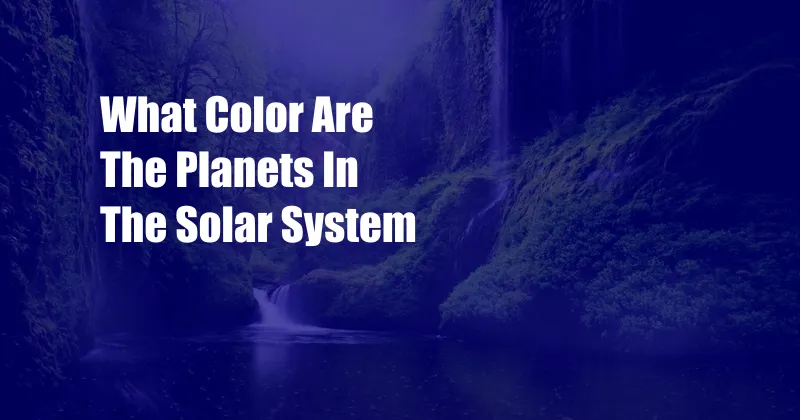
The Colors of Our Cosmic Neighbors: Exploring the Solar System’s Celestial Hues
From a young age, we’ve marveled at the grandeur of the night sky, captivated by the celestial tapestry studded with shimmering stars and planets. While countless legends and stories have been woven around these celestial bodies, have you ever wondered about their true colors? In this blog post, we’ll embark on an interplanetary journey to unravel the vibrant hues that paint the planets of our solar system.
Before delving into the celestial color palette, let’s first understand the factors that determine a planet’s appearance. Atmospheric composition, surface conditions, and the amount of sunlight reflected all play a crucial role in shaping the way we perceive these cosmic bodies.
Blue Planets: A Realm of Azure and Aqua
The azure expanse of Earth’s oceans dominates our planet’s appearance from space. This vibrant blue is a result of selective absorption and scattering of sunlight by water molecules in the atmosphere, a phenomenon known as Rayleigh scattering. A similar mechanism colors Neptune and Uranus in different shades of blue, with Uranus exhibiting a distinctively greenish hue due to the absorption of red light by methane in its atmosphere.
At the other end of the blue spectrum lies Pluto, once considered the ninth planet but now classified as a dwarf planet. Its icy surface, covered in frozen nitrogen and methane, reflects a bluish-white light, giving it an ethereal glow in the vast expanse of space.
Red Planets: Fiery Hues and Iron Oxide
Perhaps the most famous red planet is Mars, often referred to as the “Red Planet” due to its distinctive rusty hue. This rich color is attributed to the presence of iron oxide, or rust, on Mars’ surface. The iron oxide is formed through a chemical reaction between the planet’s surface and the oxygen in its atmosphere.
Venus, despite its dazzling brilliance, also exhibits a reddish-orange glow. This is caused by the dense carbon dioxide atmosphere that envelops the planet, scattering the sunlight and giving Venus its fiery appearance.
Yellow Planets: Dusty Hues and Sulfur Compounds
Jupiter, the largest planet in our solar system, is adorned with an array of swirling clouds that create a mesmerizing tapestry of colors. However, its predominant hue is a pale yellow, caused by the presence of ammonia crystals and sulfur compounds in its atmosphere. These compounds absorb blue and red light, resulting in the planet’s yellowish appearance.
Saturn, known for its magnificent rings, also displays a pale yellow hue due to similar atmospheric conditions. The presence of ammonium hydrosulfide in Saturn’s atmosphere further contributes to its distinctive color, giving it a slightly greenish-yellow tint.
White Planets: Icy Giants and Reflective Clouds
At the far end of the solar system, we encounter the ice giants Uranus and Neptune. Their predominantly white appearance is due to the dense clouds of methane and hydrogen that envelop their surfaces. These clouds effectively reflect sunlight, giving the planets a bright, icy glow.
Even Pluto, the dwarf planet at the edge of our solar system, exhibits a white surface due to its covering of frozen nitrogen and methane. This icy mantle reflects sunlight, making Pluto appear as a bright spot amidst the darkness of space.
Tips for Exploring the Colorful Planets
With advancements in telescopes and space exploration technology, we have gained unprecedented access to the celestial bodies in our solar system. Here are some tips for enhancing your cosmic exploration:
**Use a telescope or binoculars:** A telescope or binoculars will allow you to observe the planets in greater detail, revealing their colors and surface features.
**Check weather forecasts:** Clear skies and minimal light pollution are ideal conditions for observing the planets. Consult weather forecasts to determine the best viewing times.
**Visit planetariums:** Planetariums offer immersive experiences where you can explore the solar system and learn about the planets’ colors and other intriguing aspects.
Frequently Asked Questions (FAQs)
Q: Why do planets have different colors?
A: The colors of planets are influenced by several factors, including atmospheric composition, surface conditions, and the amount of sunlight reflected.
Q: Which planet is known as the “Red Planet”?
A: Mars is known as the “Red Planet” due to the presence of iron oxide on its surface, giving it a distinctive rusty hue.
Q: What causes Jupiter’s vibrant colors?
A: Jupiter’s swirling clouds contain ammonia crystals and sulfur compounds, which absorb blue and red light, resulting in the planet’s predominantly yellow appearance.
Q: Why does Saturn appear slightly greenish-yellow?
A: Saturn’s pale yellow hue is due to the presence of ammonium hydrosulfide in its atmosphere, which gives it a greenish-yellow tint.
Q: Which dwarf planet is covered in frozen nitrogen and methane?
A: Pluto, once considered a planet but now classified as a dwarf planet, has a white surface due to its covering of frozen nitrogen and methane.
Conclusion
Exploring the colors of the planets in our solar system is a journey that unravels the mysteries and beauty of the cosmos. From the vibrant blues of Neptune and Earth to the fiery hues of Mars and Venus, each planet’s appearance tells a unique story about its composition and evolution. With patience, dedication, and the right tools, we can continue to explore these celestial wonders and deepen our understanding of their true nature.
So, are you ready to embark on an interplanetary adventure through the colorful tapestry of our solar system?